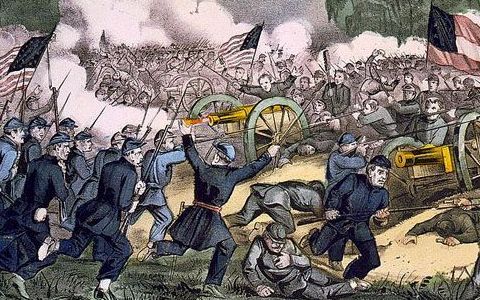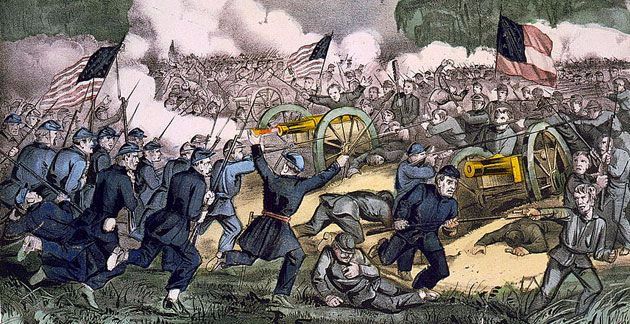Local communities in both the North and South mobilized efforts to organize and equip the armies of the Civil War. In August, 1862, the Jewish community of Chicago met in a series of meetings at the Concordia Club to organize a Jewish company for a new Illinois regiment to be comprised of German and Scandinavian immigrants under the command of Colonel Frederick Hecker. Col.
Hecker was himself a leading “Forty-eighter,” whose own poorly armed force was badly routed at Baden in April, 1848. A resolution was drafted, the community raised an initial $6,200 in its first night, and forty-two men volunteered at the recruiting office which opened the following day. Captain Jacob LaSalle was assigned as company commander, and presented in a ceremony with “an elegant sword, sash and belt.”
The flag which cost $152, purchased and hand-inscribed by the women of the Chicago Jewish community with the words “82nd Regiment Illinois Volunteers,” was formally presented to Col. Hecker, who designated the Jewish company with the honor of regimental color guard (Meites, p. 90-91). Ultimately, a full company of ninety-six volunteers and $11,000 were raised for the company named the Concordia Guards. The Chicago Tribune reported, “Our Israelite citizens have gone beyond even their most sanguine expectations.
Their princely contribution of itself is a record which must ever redound to their patriotism. The rapidity with which the company was enlisted has not its equal in the history of recruiting” (Korn, p. 119).
By the end of 1862, war was an American way of life. War influenced the decisions of individuals and communities in much the same way that nature’s catastrophic winds, rains and floods influence the decisions of farmers, teamsters and merchants. Early Union victories in Tennessee, Arkansas and Mississippi led to black market cotton speculation all over the river country in General Ulysses S. Grant’s Department of the Tennessee, funneling money and contraband goods through Memphis, Paducah, Helena and points south.
In December, 1862, only several weeks after the Concordia Guards had been mustered into service with the Hecker Regiment as Company C of the 82nd Illinois Volunteer Infantry, a scandal concerning “the Jews, as a class” implicated General Ulysses S. Grant. Known by some officers, including Colonel John DuBois, as “the Jew Order,” General Order No. 11 required Jews “as a class” to leave all areas within the Department of the Tennessee, or else “be arrested and held in confinement until an opportunity occurs of sending them out as prisoners” (Korn, p. 122-123). A Wall Street rumor had it that “the Jews” were buying up gold in northern cities, taking it south to invest in cotton and financing the Confederate war effort for a profit; and doing it presumably “as a class.” By the end of the first week in January, however, General-in-Chief Henry W. Halleck had revoked Order No. 11 by order of President Lincoln.
The Jew Order went on to haunt Grant in his 1868 presidential campaign. But Grant withstood the military scandal and its political rebound, and in 1870 President Grant appointed Edward Selig Salomon, a Jewish veteran who served with the rank of colonel in, and ultimately commanded, the Hecker Regiment during the war, as Territorial Governor of Washington.
Born on Christmas Day in Schlesswig-Holstein, Edward Selig Salomon came to the United States in 1855 when he was 17, and was among the first Jews, if not the first, to practice law in Chicago. When the war began, Salomon was an alderman in Chicago’s Sixth Ward and the youngest member of the city council. With the attack on Fort Sumter in Charleston harbor that ignited the war, Salomon enlisted on May 6, 1861, in Colonel Hecker’s first regiment, the 24th Illinois Volunteer Infantry.
Distrust between the rival German and German-speaking Hungarian militias comprising the regiment immediately manifest among the officers of the 24th Illinois, leading to the resignation of Col. Hecker and his loyal faction, including then-Major Salomon. Hecker and Salomon were reunited at the Concordia Club as the Jewish company was recruited and funded.
Col. Hecker was wounded in the regiment’s first action at the battle of Chancellorsville, Virginia, in May, 1863, while Lt. Colonel Salomon recovered from illness in time to rejoin the new Hecker Regiment shortly thereafter, and as General Robert E. Lee moved his Army of Northern Virginia across the Potomac toward Pennsylvania.
Neither General Lee nor the new commander of the Army of the Potomac, General George Meade, had planned to fight a battle at Gettysburg, as Salomon would later write, “but events shaped themselves, and Gettysburg, which, up to the 1st of July, 1863, had been an obscure little hamlet in Pennsylvania, old fashioned and sedate, in a beautiful and peaceful valley, became a place of great historic importance, the place where the great forces of a great but divided people were to decide forever the question, whether or not a government of the people for the people and by the people should endure…” (Salomon, p. 6).
After confused and frantic street fighting to cover the retreat through the city of Gettysburg on the first day of the battle, and as the regiment under his command reached the higher ground of Cemetery Hill, Salomon had his first of two horses shot out from under him at Gettysburg. The rest of Lee’s and Meade’s armies would arrive at Gettysburg by the following afternoon, Thursday, July 2.
During an artillery duel on the second day of the battle, Salomon had his second horse shot out from under him by a ricocheting round of solid shot. Meanwhile, Confederate sharpshooters had taken positions in several nearby houses, “from where they picked off our cannoniers and officers at a rapid rate,” Salomon wrote. General Oliver O. Howard ordered the colonel to call up volunteers to clear the houses of the sharpshooters. Salomon selected about forty men from among those who volunteered, and requested that Captain Joseph B. Greenhut lead the mission.
Joseph B. Greenhut was born in Austria and brought to Chicago by his parents in 1852 when he was nine years old. Greenhut was among the first to volunteer for service, rising quickly to the rank of sergeant. But early in the war his arm was wounded badly enough during the capture of Fort Donelson, Tennessee, that he was mustered out of the army. Greenhut reenlisted upon his recovery and was appointed captain of Company K in the Hecker Regiment, as the Concordia Guards were being recruited in Chicago.
The Confederate sharpshooters were about one hundred yards below the Federal lines on Cemetery Hill. Greenhut wrote, “General Schurz requested Colonel Solomon [sic] to send a detail of about one hundred men to dislodge the sharpshooters. I had the honor to command that detail which was made up of volunteers, and stormed those houses, driving out the sharpshooters and keeping possession of the houses the balance of the day” (Simonhoff, p. 78).
“While the attack on these sharpshooters by Captain Greenhut and his men was going on,” continued Salomon, “and while Generals Howard and Schurz watched the progress of the volunteers with me, I called the attention of General Howard to a sign which read about as follows: ‘Driving, riding and shooting on these grounds strictly prohibited. Any person violating this ordinance will be punished by fine and imprisonment.’ I told the General that he surely would get into trouble after the battle for violating this order. While the General was reading it a shell struck the board and knocked it into a thousand pieces. ‘Well,’ said the General, ‘the ordinance is rescinded; I think the shooting can go on.’ And nearly every monument that adorned the final resting place of the good people of Gettysburg who had passed away during the last century was knocked into splinters” (Salomon, 13-14).
A violent conflagration in and around a peaceful town’s cemetery would be a fitting enough metaphor for the pivotal battle of the American Civil War, if it had not in fact occurred exactly that way. The war seems to have delivered its brutality upon man and beast, both living and dead, with no discrimination or prejudice. History itself continued to have its macabre way with Captain Greenhut, as he was appointed to the Illinois governor’s commission to erect a monument in honor of the state’s soldiers at the national battlefield memorial at Gettysburg.
On September 3, 1891, Joseph B. Greenhut recounted his experience of the battle at the dedication of the monument. “All of us can recollect the myriads of shells and bombs that flew in our midst and over our heads,” said Greenhut, “dealing out death wherever they struck in our ranks, and few of the headstones which marked the graves in the old cemetery were left unbroken after that shower of shells.”
After Gettysburg, the Concordia Guards and the 82nd Illinois were transferred west, where they took part in the grinding campaigns of Chattanooga, Atlanta and Sherman’s march across Georgia and the Carolinas. Captain Greenhut was promoted to the rank of brevet colonel and appointed adjutant general and Chief of Staff of the Third Brigade under General Hecker. But by the beginning of the Atlanta campaign Hecker was retired and Greenhut resigned. Colonel Salomon led the regiment through the fall of Atlanta and served on General Howard’s staff as provost marshal general, but missed Sherman’s march having been assigned to deliver messages to Departmental headquarters in Nashville.
Salomon rejoined the regiment in December 1864, and finished the war a brevet brigadier general. Salomon was elected Cook County Clerk in the fall of 1865, continuing his pre-war political career that would culminate with President Grant’s appointment of him as Territorial Governor of Washington.
Out of the 82nd Illinois’ 900 troops, only 310 returned to Chicago. What was left of Company C still carried the regimental flag, the gift of the Jewish women of Chicago. On its way to Springfield to be mustered out of service, the regiment gathered at Chicago’s ritzy Tremont House where it was addressed by “Long John” Wentworth, Chicago’s mayor at the beginning of the war and at the formation of the regiment.
“A few years since,” Wentworth remarked, “there was a cry raised that ‘foreigners’ could not be trusted, and an attempt was made to disfranchise you, but when at last the time came that tried men’s souls – when native-born Americans proved false to their allegiance to their flag, and tried their utmost to tear down and trample under foot the noble structure their fathers fought and died to rear up, then you ‘foreigners’ came forward and showed yourselves true men…. I say it: you have proved that this country owes its existence to foreign immigrants” (Meites, p. 97).
Notes:
Korn, Bertram W.; American Jewry and the Civil War; Atheneum; New York (1970).
Meites, Hyman C.; History of the Jews of Chicago; Chicago Jewish Historical Society and Wellington Publishing (1924).
Salomon, Edward S., Brevet Brigadier General, Lt. Col. 82nd Illinois Infantry; Gettysburg: War Paper No. 24, Commandery of the State of California, Military Order of the Loyal Legion of the US (1913).
Simonoff, Harry; Jewish Participants in the Civil War; Arco Publishing Company, Inc., New York (1963).
Read more: http://forward.com/scribe/365290/the-secret-jewish-history-of-the-civil-war/




